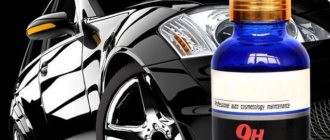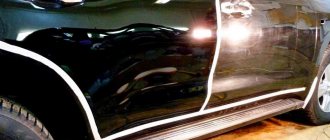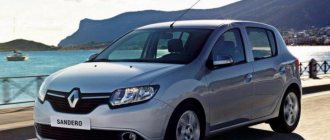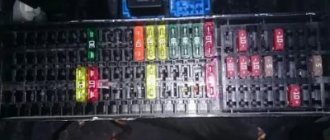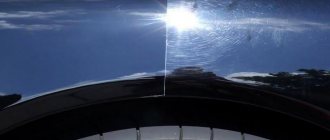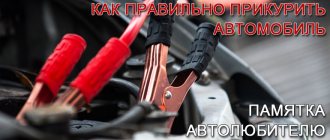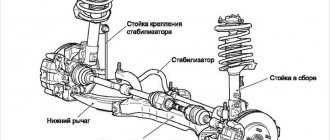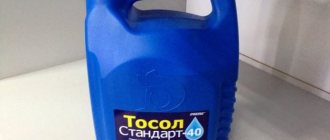Coating a car with liquid glass is necessary for additional protection of the body from scratches, exposure to temperature conditions and moisture. The average service life of such a shell is from 9 to 12 months, after which it will require updating. In addition to its protective properties, liquid glass also has a good aesthetic appearance. Therefore, the demand for it is growing every day.
Liquid glass for a car - what is it and what is it for?
The body is the most vulnerable element of the car, requiring constant care and protection. In the factory version, it is covered with 2-3 layers of paint and varnish, which gives it the ability to repel moisture and not be affected by temperature at first. But such protection is enough for a maximum of three years.
Well, in order not to repaint the body after this period, motorists use additional protection based on a silicon compound - liquid glass. Like ordinary household ceramics, it contains sand and salt compounds that act as silicates.
Important !
Instead of silicon, liquid glass may contain an interchangeable element, for example, sodium or potassium. These alkaline solutions have already found their use in construction, as office glue. Well, thanks to a special sand sintering system, they can now be used to protect car bodies. Liquid glass also contains titanium and aluminum oxide. When exposed to high temperatures, this element forms a thin film that protects other coating materials from thermal effects. Visually, such a film can be identified by its characteristic shine, similar to gloss.
The remaining active elements located under the titanium oxide film perform the function of cleaning the surface of the body from dirt, dust and other debris accumulated on it. Due to this, liquid glass is perfectly attached to a steel surface, giving it a factory aesthetic (scratches become visually invisible, stains from chemical cleaners, metal brushes, and other elements harmful to the body disappear).
Additional Information! Liquid glass feels like silicone. The silicon base gives it this effect. It also protects the body from corrosion and oxidation processes.
The active elements of liquid glass can be used in different proportions. The level of transparency of the finished coating, its adhesion ability and service life depend on this. Therefore, you need to be very careful when choosing a protective material.
Which liquid glass for the body to choose
Before processing, it is important to make sure what kind of liquid glass will be used. The fact is that both the application technology and the quality of the composition itself are considered the key to a successful result and lasting effect. Moreover, recently there have been a large number of cheap analogues and low-grade fakes on the market, which also increases the requirements for the quality of the composition.
In general, we can distinguish the leading manufacturers of liquid glass:
- Japanese composition Wilson Silane
- American Mothers
- German Sonax.
At the same time, the first option is most widely used and is considered optimal in terms of quality and price. Other formulations are also of high quality, but the price is higher. Please note that the popular Wilson Silane Guard compound is often counterfeited! For this reason, you need to buy this liquid glass only from trusted suppliers.
Differences between types of liquid glass with different substances in the base
Liquid glass has a very wide range of applications. It is used as office glue in everyday life, for waterproofing in construction and to protect car body parts. In the latter case, the glass base may consist of three main elements:
- Potassium silicate;
- Sodium solution;
- Lithium compound.
The first base is characterized by increased hygroscopicity and a looser structure. The second element is the most resistant to thermal effects. And the third connection provides the body with comprehensive protection from temperature changes and moisture ingress.
Potassium coating
Potassium silicate is the most popular alternative to sodium solution. In consistency, it resembles a viscous, viscous liquid with a transparent structure (occasionally with a greenish tint). Its cost is slightly higher than sodium-based liquid glass.
This difference in cost is explained by the antibacterial properties of potassium. Thanks to them, the car body receives reliable protection from fungus, chemical acids, and bacteria that destroy the paintwork from the inside. Potassium silicate also has good adhesion, which makes liquid glass based on it available for use not only on steel surfaces, but also on wood or plastic.
Important ! Potassium silicate gives the car body a glossy shine comparable to the shine of regular nail polish. But this has its disadvantage: it is made from toxic elements.
Sodium coating
The consistency of the sodium solution is similar to a thick, grayish liquid, with an increased level of viscosity. Has good waterproofing. Able to protect the body surface from temperature influences. Helps remove stagnant dirt on the car surface and small scratches. The cost is inferior to potassium and lithium analogues.
Lithium coating
Lithium compound is the rarest base for liquid glass. It is used in limited quantities to provide comprehensive protection of surfaces from the effects of temperature changes, moisture and other negative factors. The consistency of this material resembles a transparent, viscous liquid. After hardening, it gives the body a characteristic shine.
Additional Information! Liquid glass based on a lithium compound is used as factory protection for the bodies of some exclusive cars. For budget models, such protection is practically not used due to the high cost of the material.
What are the advantages of “liquid glass”
Each car polish has its own advantages and disadvantages. The advantages of “nanoceramic” polishes most often include:
- Significantly stronger protective layer than most wax and silicone based polishes. Thanks to the “glassy” properties of silicon dioxide included in the composition, the glossy surface of a car coated with “liquid glass” lasts much longer (in “greenhouse” European conditions, the protective layer can last 2-3 years, and in difficult Russian conditions about six months to a year ).
- Increased hydrophobicity. Since the nanoceramic composition was originally developed for waterproofing in construction, drops of water do not linger on a car coated with this composition.
- Thanks to the good hydrophobicity of the “nanoceramics”, the car keeps the body clean for a long time, repelling dirt and dust. When visiting a car wash, it is much easier to wash a car coated with “liquid glass” from dirt.
- Good resistance of the coating to various reagents, which are used to abundantly water roads in big cities in winter.
- A protective film with “glass” properties also helps to reflect most of the sunlight, which has a beneficial effect on the car’s paintwork and reduces its “fading” in the sun.
But the main advantage of “liquid glass”, for which most motorists love it, is its impressive mirror effect, which provides the car with a sparkling glossy surface that is almost impossible to achieve with conventional polishes.
How to choose a liquid glass manufacturer
With the growing popularity of liquid glass, more and more manufacturers began to appear on the market offering products of poor quality. But they can be easily avoided by following simple rules:
- Check the composition of liquid glass (most often it is potassium or sodium);
- Compare its cost with similar offers from other manufacturers (products that are too cheap can be immediately crossed off the list);
- Visually familiarize yourself with the proposed protective material (good potassium glass in liquid form will be quite viscous, with a greenish tint. But sodium-based glass can be distinguished by its gray color and liquid consistency).
You might be interested in Top 100 most expensive cars in the world and their prices in rubles 2021 (370 photos)
It would be a good idea to study reviews from experienced motorists on the Internet. There you can also find a complete list of reliable suppliers of liquid glass.
No. 11. Basement waterproofing with liquid glass
Treating the interior walls of basements is not very different from waterproofing the foundation, but some experts recommend preparing the solution according to a different principle, mixing cement, sand and liquid glass in a ratio of 1.5:1.5:4. The mass fraction of water should not exceed 25%.
The surface, as in previous methods, is first cleaned; you can treat it with an antiseptic for added importance. Then the resulting mixture is applied to the base. It is better to pre-embroider cracks and joints.
What is the difference between liquid glass and ceramics in cars?
Liquid glass and ceramics usually have the same composition. But their structure will always be different. For example, ceramics are famous for their ordered structure, which provides the protective composition with increased density. Glass has a chaotic structure of elements, due to which it has a liquid consistency.
Important ! Ceramics is the same glass that has been processed at high temperatures. Therefore, it is characterized by increased resistance to chemical and thermal influences.
Ceramic or liquid glass for cars – which is better?
Features and interesting facts
Nikita
Journalist, auto magazine "Robot"
Ask a Question
Compared to liquid glass, ceramics have a higher level of wear, due to which its service life increases to 1.5 - 2 years (for glass, the maximum life is 12 months). Ceramic coating also boasts good adhesion, thanks to which it can adhere not only to metal, but also to glass. Well, the only drawback of this material is its high cost, which is not suitable for cars in the budget segment.
Besides shine, what does liquid glass provide for paintwork?
Liquid glass has a number of positive properties. In the case of its use to cover a car body, these will be:
- Protection from scratches, temperature changes, moisture and other negative influences;
- Giving the surface an aesthetic appearance;
- Cleaning the body of old micro debris, followed by stopping corrosion or oxidation;
- Protection against fungal bacteria and chemicals;
- Ensuring fire resistance;
- Reducing the likelihood of an electrical charge forming on the body.
This is a complete list of the beneficial properties of liquid glass. Depending on the main active element and its amount in the protective composition, it may be slightly reduced.
How much does it cost to cover a car with liquid glass?
With the price of liquid glass at 1000-6000 at a service station, you will have to pay 5000-17000 for one procedure, depending on the class of car. The course is extortionate, however, it is payment for free time. If you have enough of it, go to the store and take a closer look at polishes. The best are considered:
- Wilson Liquid glass covers 60% of the country's cars. It is used in service centers and at home. Packaged in containers of 100 and 500 ml. A small bottle is enough for 2 procedures. Price from 1500–7000. It's easy to calculate how much you save by doing the polishing yourself.
- “Liqui-Moli” Reviews about liquid glass are the most positive. Car owners say that the car changes before their eyes: the sun reflects on the sides of the body, water flows down as if it had fallen on a wax surface. The price of a small bottle is 3000 rubles. We must pay tribute to German quality - a single polish will remain on the car even after several months and will survive up to 50 washes.
- “AQuly” I call this product a polish for the lazy. One polish will provide the car with a protective coating for 5 weeks. The price is similar to Wilson. At the same cost, it is better to give preference to the latter.
The product does not require additional tools, which allows you to save on it. But it should be borne in mind that the surface of the body must be cleaned with special care before applying it. This means that you will need to take into account the cost of these works, which require the purchase of additional materials. In total: covering a car with liquid glass is not a small price...
Real service life of liquid glass on a car
When covering a car body with liquid glass, manufacturers provide a guarantee for their work from 9 to 12 months. But the actual service life of such a protective coating directly depends on the conditions of its operation and the area (large city with dense traffic flow, rural area, or urban area, with moderate traffic).
Important ! The average service life of liquid glass is determined based on moderately severe conditions. We are talking about moderate traffic, normal amounts of dust and no physical impact.
How long does liquid glass coating on a car last?
If a car coated with “liquid glass” is used daily, its service life will be limited to one year under normal conditions, and 6-8 months under dense traffic flow and increased dust levels. If the car is stored in a garage for a long time and only driven out 2-3 times a week, then the protective material on the body can last up to three years.
Real possibilities of maintaining coverage in Moscow conditions
Due to the specifics of the road surface and dense traffic flow in the capital Moscow, the service life of liquid glass is significantly reduced (from 4 to 7 months). In the case of daily use of the machine, another 1 - 1.5 months can be subtracted from this period. Well, without additional protection, a car can go from new to junk in just 2-3 years.
Important !
Frequent washing of the car body significantly reduces the service life of liquid glass. On average, this procedure should be carried out once every 2-3 weeks. If washing occurs more often, the average period of use of the protective coating is reduced by another 15-30 days.
TOP 10 brands of liquid glass for cars
Reviews from experienced car enthusiasts from different regions of the Russian Federation allow us to create the TOP 10 best brands of liquid glass for cars. This list includes:
- Willson silane guard (Japan);
- Soft 99 Glass Coating H-7 (Japan);
- Ceramic Pro 9H (Taiwan);
- HKC Ceramic Coating (Estonia);
- Gyeon Q2 Prime (Korea);
- Gyeon MOHS+ (Korea);
- Ceramic Pro 7H (Taiwan);
- Willson Body Glass Guard (Japan);
- Gyeon MOHS (Korea);
- Williams Ceramic Coat (UK).
All listed samples belong to the middle and luxury price segments. Their cost ranges from 8,000 to 23,500 rubles for 50 ml of solution (the price is current for 2021).
The best liquid glass in the middle price segment
The best liquid glass in the middle price segment is determined by the price/quality criterion. You should not expect comprehensive body protection from it. Such material is most often capable of performing 2-3 functions, not counting its aesthetic appearance. In total, car enthusiasts identify the five best models of liquid glass.
Willson silane guard
Japanese products with an optimal price/quality ratio. Sold in 95 ml packs, paired with a minimum set of tools for glass installation:
- Polishing cloth;
- Gloves;
- Sponge.
The main active element of this protective material is silicon. Additionally, Willson silane guard contains: isoparaffin, alcosilane, alkoxysilocane and nonane. All these components together provide the coating with good adhesion, a glossy shine and reliable protection of the body from scratches and moisture.
Ceramic Pro 9h
Liquid glass based on lithium compound. Provides the body with lasting protection against corrosion, temperature and moisture. Sold in 50 ml bottles. When applied in 2-3 layers it can last up to 10 years. The only drawback is the very high cost (the most expensive brand of glass in the middle price segment).
Gyeon Q2 Prime
Korean liquid glass based on sodium solution. Sold in disposable cylinders, 50 mg each. Provides the car body with a glossy shine and protection from temperature influences. Capable of removing stagnant dirt from surfaces, thereby preventing the development of corrosion and oxidation.
Additional Information ! The Gyeon Q2 Prime glass is similar to the Chinese model 58 XCAR, but with a cheaper price tag. You can purchase one cylinder of such coating for 3-6 thousand rubles. (price is valid for 2021).
Soft 99 Glass Coating H-7
Liquid glass based on potassium silicate. It has good adhesion, due to which this coating can be applied to any painted surface. Sold in 100 ml bottles. Does not require preliminary preparation of the body. Able to provide the car with protection from moisture and bacteria that form fungus. Gives a glossy shine to any surface. The average cost of one cylinder of Soft 99 Glass Coating H-7 is 3,000 rubles (the price is current for 2020).
You may be interested in this. Best SUV price-quality. TOP 10 (pros and cons)
HKC Ceramic Coating 2.2
The most durable protective coating based on sodium solution. Sold in 95 ml bottles. Has good waterproofing. Can be used in areas with heavy dust. Before applying HKC Ceramic Coating 2.2 glass, the car body must be carefully prepared, which can be attributed to the disadvantages of the product. This material also has poor heat resistance, which complicates the process of applying it to the body. The average cost of one cylinder is from 15,000 rubles (the price is current for 2021).
No. 6. Liquid glass for concrete waterproofing
The popularity of liquid glass is associated precisely with its addition to concrete mortar. The essence of the method would seem to be clear, but to get a truly high-quality result, you need to know several nuances:
- Liquid glass cannot be added to the prepared liquid solution. First, prepare a dry mixture, and then dilute it with water, to which a certain part of liquid glass is added;
- the amount of liquid glass can vary widely - it all depends on your goals. Having chosen a specific recipe, it is very important to follow the specified proportions. The minimum content of liquid glass in concrete is 2% (this composition is used for waterproofing the foundation), the maximum is 25%;
- liquid glass improves the quality of the solution, but greatly affects the speed of its hardening. It is recommended to prepare the solution in small portions so that it does not harden while still in the container. For the same reason, many do not recommend using a concrete mixer.
If you add only 2-3% liquid glass to the solution, the concrete will begin to set within 45 minutes, and will completely harden after a day. This is a fairly popular proportion. When adding 5% liquid glass, the setting speed will be reduced to 30 minutes, and complete hardening will occur after 16 hours. For 8% these figures will be 15 minutes and 7 hours, and for 10% - 5 minutes and 4 hours, respectively. For mixing, use clean cold water and cement grades M300 and M400.
The mixing principle is as follows:
- take a container with clean water, add liquid glass there, mix;
- the solution is poured into a larger container and a dry cement-sand mixture is gradually introduced;
- quickly but thoroughly mix the mixture until smooth and get to work.
All work is carried out in special clothing and gloves.
The best liquid glass from AliExpress
Chinese AliExpress is replete with counterfeit products of all categories, including liquid glass for cars. But among all these products there are also worthy brands that can be purchased at a low price, without sacrificing quality. There are about five such manufacturers in total.
Liquid glass AUTO CARE BPAP 41
Liquid glass based on sodium solution. Sold in cylinders with a capacity of 100 ml. One such container is enough to cover a car in two layers. The average price of one bottle is 850 rubles. (price is valid for 2021). For this money, the motorist will receive: protection from moisture, a glossy shine on the body, as well as hiding old scratches and microcracks. The service life of AUTO CARE BPAP 41 glass is 6-7 months.
Liquid glass SIKEO ANTI-SCRATCH
Protective coating based on potassium silicate. Produced in bottles of 30 ml. This material easily masks scratches and cracks on the car body, erases outdated debris from surfaces and provides steel elements with corrosion protection. The only disadvantages of SIKEO ANTI-SCRATCH glass are poor resistance to moisture and long drying times. Well, its average cost fluctuates around 860 rubles (the price is current for 2021).
Liquid glass CARPRIE
Very cheap Chinese liquid glass, created on the basis of sodium. One bottle contains 30 ml of this protective coating, and the manufacturer provides a sponge and a polishing cloth to accompany it. The cost of such a set is 480 rubles. (price is current for 2020). For this money, the motorist gets a glossy body shine and excellent water protection. One layer of CARPRIE glass can withstand up to 4 months of use.
Important ! When applying the product in 2-3 layers, the base period increases by 60-90 days. After treating the body with CARPRIE glass, it is advisable to protect the car from moisture for 2-3 weeks.
Liquid glass DPRO DF-100
Liquid glass based on potassium silicate. Supplied in 100 ml volumetric cylinders. Provides the car body with lasting protection against corrosion and oxidation, erases old stains and scratches. One layer of DPRO DF-100 is enough for 3-4 months of operation, in moderate conditions. The cost of such a protective coating reaches 750 rubles. per cylinder (price valid for 2021).
Liquid glass JLEC WF001
Protective coating-polish, based on sodium solution. Provides reliable protection of the body from moisture and bacteria that cause fungus. Sold in bottles of 100 ml. The average service life of such material is 90-120 days. The maximum number of washes during this period should not exceed 20 times. Otherwise, the warranty period will be significantly reduced. The cost of one bottle on AliExpress reaches 750 rubles (the price is current for 2020).
No. 3. Areas of application of liquid glass
Essentially, liquid glass can be used in three main ways:
- the composition is applied to the concrete surface, dries and forms a moisture-resistant film, clogging all pores. Often the protection is applied in several layers;
- the composition is added to the concrete solution. A concrete structure created in this way receives improved waterproofing properties, but at the same time hardens much faster;
- as an additive for the production of different grades of concrete.
To convince you of the versatility and practicality of this waterproofing material, we present only the most common areas where liquid glass is used:
- covering the foundation, walls, ceilings and floors in basements;
- waterproofing of swimming pools and wells;
- waterproofing wood;
- added to concrete to improve water-repellent properties;
- protection of tree trunks after cutting;
- gluing different materials;
- to combat mold;
- for protection against corrosion;
- to protect seams between building materials;
- much less frequently, the composition is used to remove dust from concrete, and also as a quick-drying substance. It is also rarely used to create bactericidal grouts and as a sealant.
Surface preparation and coating of a car with liquid glass
It is always advisable to prepare the surface for the application of liquid glass, regardless of the chosen manufacturer of the protective material and its quality. Well, for the budget segment this process is simply necessary. The level of adhesion of the silicone coating to the body directly depends on it.
If liquid glass is applied not with your own hands, but with the help of specialists, then the car owner will not have to prepare the working surface in advance. This is the responsibility of the master. But if you cover the car yourself with a protective material, you will save about 50% of the money.
How long should I plan to treat my car with liquid glass?
If you have minimal skills in working with liquid glass, the process of covering the body with this material will take you no more than 3-4 hours. Beginners will have to tinker with the protective coating a little longer - up to 6-7 hours. Well, the car owner will see the first results of his work no earlier than 12 hours after applying the liquid to the body. This is the period of minimal hardening of the solution.
Important ! For liquid glass to completely set, it takes at least 14 days. Until the end of this period, it is not recommended to use the car every day, and especially in heavy traffic. Also, within two weeks after applying liquid glass, the car must not be washed.
Liquid glass coating technology
Application of liquid glass must be carried out in accordance with the instructions and according to the technology established by the manufacturer. Only then can you be sure of a quality result. Surface treatment is allowed at ambient temperatures of +10…+40 degrees.
Note! If the car has just been driven from the street into the box in the summer, the metal of the body can be heated to 70 degrees and needs to be allowed to cool. Even in winter, the hood, in the area above the engine, can get very hot, so you should wait 10-15 minutes.
The application procedure is carried out in a garage or hangar, without direct sunlight. It is important that the room is well lit for better visibility of the surface and evaluation of the result. Application is allowed on all body parts, including plastic bumpers, chrome elements, and headlights. The exception is the windshield, side and rear glass, and the reflective part of the mirrors. The action takes place on a dust-free surface. It is important that no wind blows into the box, otherwise dust particles may stick to the top and ruin the coating.
The application procedure is carried out in a box
The application technology involves sequential coating of body elements, followed by rubbing, drying and polishing the surface. You cannot treat the entire body at once, since the polish will dry quickly and you will not have time to rub it properly. The action starts from the roof, then you can move on to the hood, trunk, doors, fenders, bumpers.
Advice! At the very beginning, apply polish to a small area of the body (for example, on the corner of the rear bumper), rub it, wait until it dries and polish. This will help you see how the body color will play and decide whether the composition is suitable for your car.
Consequences of applying liquid glass to a car
Most experts talk only about the positive effect of liquid glass: protection from corrosion, bacteria, moisture and temperature effects, glossy shine and increased body density. But in reality, such protective material also leaves negative consequences for the car:
- Limitations in body washing (on average, liquid glass can withstand from 20 to 40 washes);
- Demand for careful care (after treatment with liquid glass, the car will require more time from the owner for care. This is due to more careful washing of the body, without the use of special devices).
Otherwise, liquid glass is absolutely harmless to bodywork. It can be used both on new cars and on old ones with high mileage.
Important ! Liquid glass does not have protection against chips and cracks. Therefore, if it is deformed, the procedure for applying the protective material will have to be repeated.
Liquid glass for car bodies: pros and cons
This type of coating has both a number of advantages and several disadvantages. If we consider the main advantages, we can highlight the following features:
- Protection of paintwork from chemical attack and ultraviolet radiation. For example, insects that get on the paintwork release acids, and the coating is also actively destroyed by resins and aggressive reagents from the road. At the same time, liquid glass protects varnish and paint from such influences.
- Protection against minor scratches and minor mechanical impact.
In this case, the composition does not allow hard objects (for example, branches and hard grass) to scratch the paintwork, as it “slips” along the smooth polished surface. In the same way, the effect of protection against micro-scratches during aggressive washing is achieved. Liquid glass-type compositions for cars are more expensive than other traditional wax polishes, but remain affordable. Also, wide distribution allows you to buy liquid glass in almost any large auto supply store. Moreover, the service life of liquid glass is at least 6 months, while the lasting effect lasts even longer (subject to proper application). - A special thin hydrophobic layer on the body, glass and optics repels water, which prevents rapid contamination of surfaces and keeps the body clean longer. Also, processing with liquid glass allows you to obtain high gloss and deep color saturation of paintwork and optics. The car after treatment looks even better than freshly painted.
Disadvantages of liquid glass
- First of all, liquid glass does not provide protection against flying stones (chips) and strong mechanical impact (scratches during an accident, etc.). Liquid glass will not protect the body from strong temperature changes, and the coating itself will begin to crack in such conditions, since it does not have much plasticity.
- It should also be noted that there is a separate difficulty during application.
It is important to know how to apply liquid glass correctly, have the appropriate equipment and have professional car body polishing skills. The car also needs to be prepared before processing (washing, drying, degreasing, deep restorative polishing and paintwork repair). At the same time, liquid glass is not able to remove deep scratches and hide serious defects. Moreover, if these defects are not removed before processing, in bright sunlight and active artificial lighting the defects appear even more pronounced. - It turns out that if the paintwork is initially in poor condition, liquid glass will only highlight the imperfections against the background of other entire areas. For this reason, the application of liquid glass is recommended for cars whose paintwork initially does not have serious defects or damage.
How to care for liquid glass on a car
Caring for liquid glass is a very important aspect for a motorist. And it consists of four simple rules:
- Do not wash the car for the first 14 days after applying the protective coating;
- After a two-week period, wash the body using a non-contact method, without the use of rags, brushes and other devices;
- Do not use abrasive chemical cleaners to wash your car;
- Dry the body with warm air, without using powerful dryers.
Such care will allow liquid glass to live as long as possible. And if the above rules are violated, the service life of the protective material may be halved.
Reviews from car owners about liquid glass treatment
Features and interesting facts
Maksim
Auto mechanic at Remarque, has been interested in cars since he was 10 years old
Ask a Question
On automobile forums there is positive feedback about liquid glass. According to car owners, this protective coating gives the car a new look due to its glossy shine. The body is also protected from moisture and bacteria that cause fungus.
The only drawback of liquid glass, according to motorists, is the special requirements for car care. After all, contactless car wash is not available in every city. Therefore, these requirements cause serious difficulties for some car owners.
